A European Starling preens in a communal bath on the Seattle waterfront as a juvenile Starling wanders into the splash zone.
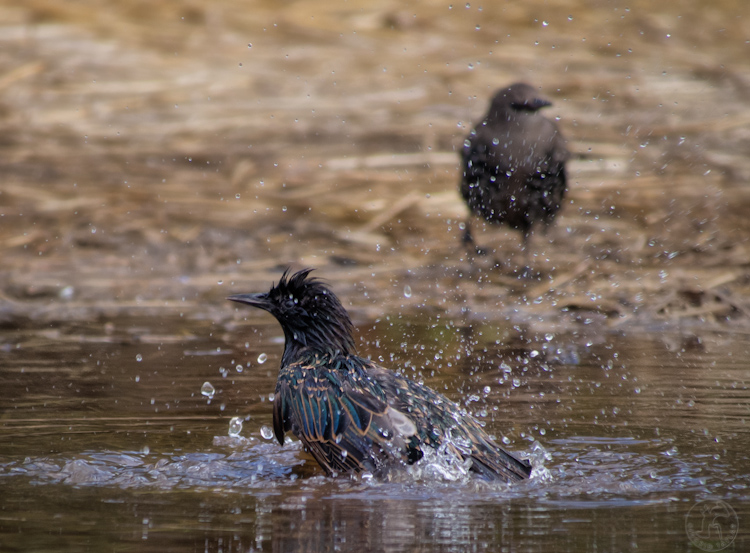
This bird bath was a series of long, narrow puddles at the edge of a bike path, visited at various times by Starlings, crows, finches and sparrows. Each time a cyclist buzzed by, the birds would all flush to the nearby shrubs with sopping feathers. Then, they’d lather, rinse and repeat as the sun drifted in and out of cloud puffs.
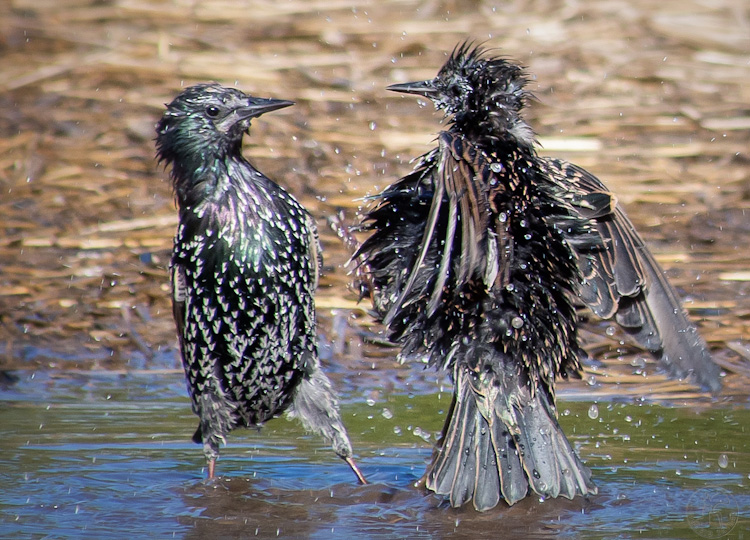
At the time I took these photos in early autumn, there was a flock of juvenile Starlings reliably present and feeding in this city park. Hugh called them “The Class of 2012” because we suspect they were the young raised under the corrugated siding of a nearby ship-loading zone. I’m always grateful when industrial or port authorities allow for the co-existence of birds like Starlings.
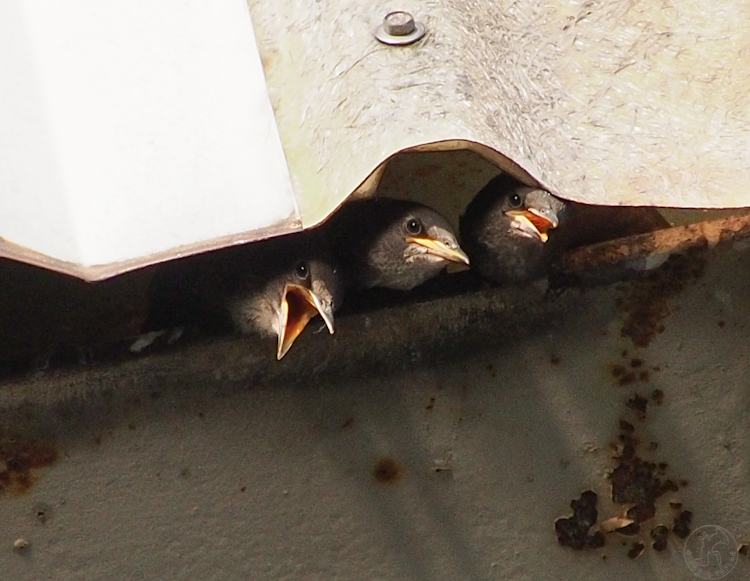
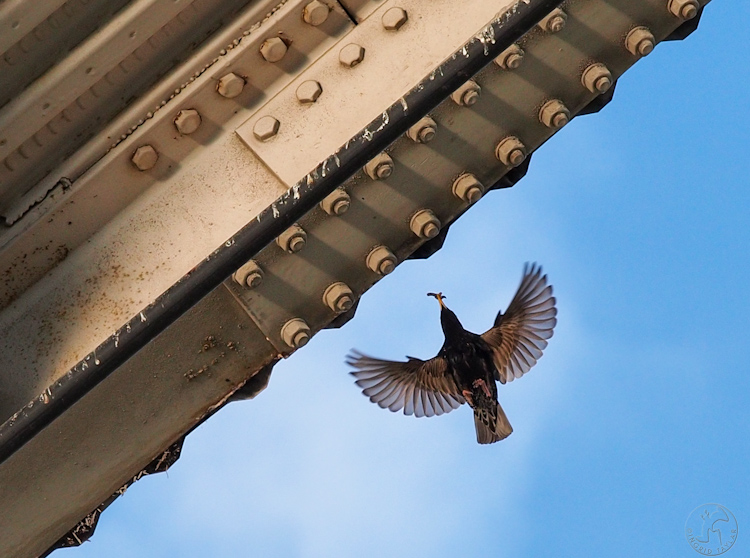
Once they fledged, we’d see them in synchronized swirls overhead, landing just to strip a few berries from shrubs or forage for dinner in an adjacent lot with grass gone to seed.
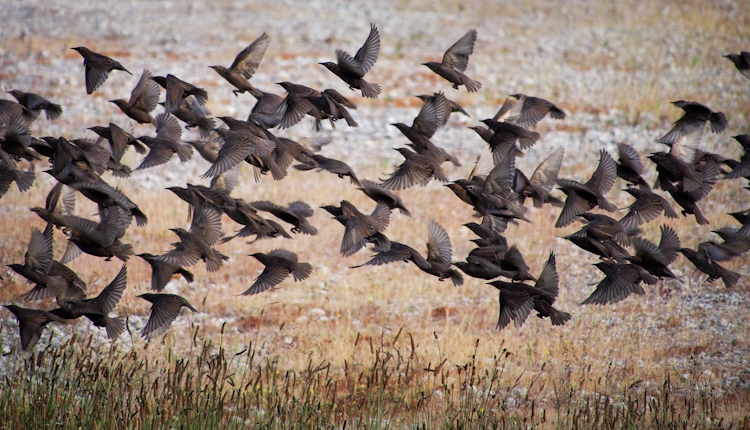
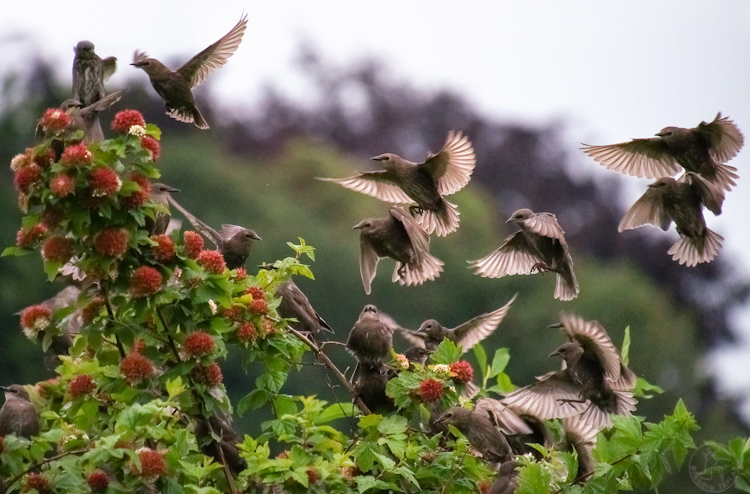

I LOVE that second bathing photo, Ingrid.
I’ll admit that I’ve been guilty of some misguided antagonism toward starlings. Blaming starlings for being here and acting like starlings is about like hating barking dogs or poorly behaved children for their behavior, rather than their owners/parents.
Ron, thanks for that lovely and candid comment. I just can’t help myself from rebelling against the paradigm. It’s my fatal flaw, in literary terms.
I am admittedly conflicted over the issues surrounding invasive species, because I care, inherently, about compassion toward individuals, humans and nonhumans alike. And I’ve seen some wretched acts toward animals based on the ‘invasive” designation, so I suppose I overcompensate.
At the same time, I see the complexity in healing our ecosystems. I was trained in a wildlife hospital which didn’t accept non-native species for reasons that abide by traditional invasives biology. In keeping with my personal ethics, I was permitted to re-home birds like baby Starlings if they came in, which I did, and which is how I ended up a temporary caretaker for birds like pigeons and Japanese Quail.
I do understand why people have some species ambivalence, but I can’t talk myself into feeling that way, for better or worse.
Nice photo story Ingrid.
Hi, Glenn! How’s life back home? I’ve been meaning to follow up with you to see if you had any news about the SF Ospreys you photographed. Did they have young and did they fledge?
No, I don’t think there were any offspring. Nothing posted on SFBirds group. But they posted that there are 7 nesting pair of osprey on Mare Island.
Drying out after a heavy rain. Our favorite grocery store Rainbow was flooded from the lack of street drainage.
I remember going to Mare Island about five years ago and finding one nesting pair on a crane. I’m delighted there are quite a few pairs there now! On cranes? Or did wildlife officials build platforms? I’ll have to do some Googling. Thanks for the info. On the Rainbow flooding … I saw that photo on SFGate, of the cyclist fording the totally flooded intersection, 18th and Valencia, I think.
Glenn, I just did a bit of sleuthing and found this comment which sounds like good news about Pier 80, but I haven’t seen any info yet on whether or not they fledged. This was the only story that mentioned chicks:
“The Port’s environmental manager, Carol Bach, confirmed that the osprey “chicks are still present at the nest atop one of the cranes” on the east or south face of Pier 80. “The best place to view the nest is from the wetlands at Pier 94,” she said, “which is open to public access. The best folks to talk about the history of sightings and current status of chicks and assist with viewing are the Golden Gate Audubon Society.”
What was the date on that report?
Glenn, it was the September issue of Potrero View, sorry, forgot to paste the link. I don’t know when Carol was interviewed for this piece though: https://www.potreroview.net/news10847.html
Hey, I saw news about Haya’s release! Were you there?
(For others here not from SF, Haya was the young Peregrine who was shot last year in Oakland, and who’s been rehabilitated since that time. Her mother, also shot, is in a captive breeding program because the extent of her injuries precluded release. Glenn here is the official photographer when the SF Peregrines are banded, etc. Here’s the most recent report on Haya: https://stewartfalcon.wordpress.com/2012/12/04/hayas-release/)
No I had to work at my day job and could not take time off.
Good to hear that there were chicks at the osprey nest, but I did not hear anything about them fledging. I’m guessing they did ok though.
It’s strange there would be no news of fledging when it was such a great development to have them nesting there. I’ll keep looking to see if I find anything.
Glenn, I was in touch with Golden Gate Audubon and was told there were no fledglings to the best of anyone’s knowledge. I asked about the report of chicks in the nest, and that may have either been erroneous, or there may have been chicks that died before fledging. No one has been up to the nest to see if there are unhatched eggs, etc. I hope they try again next year. We had an Osprey couple here in Seattle who produced no chicks the first year they nested in a cell tower, but have had two fledglings in the two subsequent years.
All of the images are nicely interwoven to illustrate the narrative. I have a problem with the “invader” designation, particularly, knowing it’s a biological term, but deeply doubting in my heart whether it’s something that humans will be able to control. I think of “invader” species as direct results of human errors, and not as “invasions”, as science has us believing and acting upon.
Maria, interesting point about the term “invasive.” At the wildlife hospital we tended to use “non-native” but even that is somewhat ambiguous when you look at how blurry the delineations can be between native and non-native. And then, there are cases where non-native plants and native animals have developed mutually beneficial relationships. The eucalyptus/Monarch relationship is an example where blanket eradication policies are not necessarily the best policy. I’ve also seen flocks of goldfinches thriving on the seeds of non-native thistle clusters in California parks only to return the next week to find the thistles destroyed for their rampant spread. Given the specificity of goldfinch diets and short of urban feeders, I always wonder how these birds acquire adequate thistle seeds in the aftermath of this eradication.
I’m trying to think of an example where ‘invasive’ problems were not the result of deliberate or inadvertent human activity. Can you think of any? I understand your sentiments. Although I realize some situations are verging out of control (pythons in Florida) it’s still difficult to view the larger ecological issues without considering our role and culpability, for better or worse.
You wrote: “I”m trying to think of an example where ‘invasive’ problems were not the result of deliberate or inadvertent human activity. Can you think of any? I understand your sentiments. Although I realize some situations are verging out of control (pythons in Florida) it’s still difficult to view the larger ecological issues without considering our role and culpability, for better or worse.” I was about to expand on this bit “vengeful” comment of mine, but I think it stems from the word itself.
I didn’t like the word “invasion” because of the broad implications as such, and now I’m going through the “invader” issue here with green iguanas, and instead I’m thinking “non-native”, or “exotic’ would be a much more appropriate term, but it’s become “the” word to use for these situations, and I am also noticing that some people are literally thinking they ARE being “invaded”. The implications of this word are very far reaching, and even if it’s a biological term with all its justifications, the typical layman in the street gets the wrong idea, and I’ve seen people shoot, strangle, and run over iguanas just because they were told they are “invasive”, and when they’re asked why did they do it, they say:”because they are invading the island”, not because they have even harmed or eaten anyone’s orchard.
I think the earth is in constant flux, with islands and continents shifting, tornadoes, hurricanes, tsunamis, earthquakes, snowstorms, eclipses, floods, etc. After natural hurricane disasters, lizards, crabs, plants, and several other species float on over on log rafts to islands and some to the U.S. to be “re-introduced” to new terrain. The Monk and Nanday parakeets (Nanday is now in the Aratinga species), probably simply as escapees from a country as far down in our map as Argentina, have “made it” all the way up to the US and they thrive.
The ones that do establish themselves as feral colonies will no be just “vagrants” (“accidentals” which will not thrive and die out), they will become “the invasive”, even worst, “super-colonisers”, and will do so out of their “adaptability” to their new environments. But this comes at the expense of the “native” species, for what will they eat when the non-natives have “succumbed” to their “main diets”??? The Pearly-eyed Thrasher has been termed a “super coloniser”, and has spread through the Caribbean during hurricanes and floods. It eats live chicks of very important “native” species in Puerto Rico just to get them out of the tree cavity it needs, to “invade” it and to be able to nest and establish its colony.
I liked it when you said in this post: “I’m always grateful when industrial or port authorities allow for the co-existence of birds like Starlings.”. It gives me hope that we can all learn from these natural occurrences, and that in fact I can gain some humility through my co-workers and “adapt” myself just as well.
Maria, you bring up some interesting and thought-provoking points. I’ve never liked the term “invasive” either, but I hadn’t fully consolidate my ideas on why. You’ve given me some things to ponder. At the wildlife hospital where I worked, we referred to them as “non-native” so I’m accustomed to using that term … all the while questioning the delineations of the label. I know this is a question that comes up in ecological terms, but, for instance, how long does an animal have to live in a reasonably symbiotic way in its environment before it could be considered an acceptable “native”? As you say, boundaries over time have been fluid, including the ones that haven’t constrained our own species which some would argue is invasive and others would defend under the auspices of our common origins.
Beautiful shots, Ingrid. I’ve long said if people weren’t told to dismiss European starlings as evil invasives that threaten our native birds (never mind that they’re here because people deliberately introduced them–the best part of having a scapegoat is that it absolves you of responsibility for any harm) it would be obvious to the most casual observer that they are a gorgeous, intelligent, adaptable and resilient species.
FYI, that “synchronized swirl” of starlings you observed is called a “murmuration.” To see a thrilling example from their native UK, check out this video on YouTube: https://www.youtube.com/watch?v=iRNqhi2ka9k
While trying to view this again on YouTube (it’s one of my ALL TIME FAVORITES) I experienced some technical problems so I thought I should let everyone know you can also see this 2 minute video on Vimeo: https://vimeo.com/31158841
Thank you, Kieran! Beautiful! (btw, the writer in me apologizes for sometimes not using the appropriate term. I plug in synonyms for fun which is precisely why I would have made a lousy scientist. But, I do happen to love the word “murmuration.” In the time I’ve spent in Europe, I have never seen the likes of these legendary murmurations. I’d love to.)
Kieran, I agree. I know the doctrine against birds like Starlings is persistent in our culture, so I understand why people come to feel that way about them. As I mentioned in an earlier piece, I personally think Starlings are important for a few other reasons, beyond their inherent value. They are often a “gateway” species that get children interested in birds, in compassion toward other species, and even in rehabilitation. That was certainly true in my case. My first, young rescues weren’t rare or even native species in some cases, they were Starlings, House Sparrows, pigeons and crows … because those are the animals urban and suburban children live among, and those are the birds you often find injured for interaction with humans, their technology and their malice. Some people also don’t realize that during nesting season, Starlings are generally cleaning up insect populations to give their babies protein. They’re seen as crop ravagers which I realize happens, and my old farming friends had no love for Starlings.
I admit that invasives biology touches on a sensitive issue for me, not because I don’t have some knowledge of the complexity of how non-native species can affect our ecosystems, and not because I don’t understand the concern many have about this. It’s just that, 1) there’s often an arbitrariness to the labels we assign species, and 2) although I know conservation is most concerned with systems as a whole, I’ve never been able to lose my concern for individuals of the species, either. That’s why Marti Kheel’s book really spoke to me, that’s why I ultimately ended up in a wildlife hospital. Of course, I volunteered alongside people who had no qualms turning away non-natives. I just couldn’t do it. On my shift, I re-homed when appropriate or found places that would take them. Some would see my feelings as a pathetic victory of heart over head.
The budding trend that concerns me right now are the groups of people adoringly referred to in the press (even venues like the New York Times) as “invasivores.” I won’t validate the promoters by mentioning names, but as the title suggests, it’s a movement to eradicate “invasives” through hunting and trapping, and some promote it as a way to eradicate all non-native species. It’s being billed in those same articles as a “sustainable” alternative to native-species hunting and to CAFOs, and I truly hope it’s fringe enough that it doesn’t become a mainstream ethic in terms of how we view wildlife. There’s a push by some to further commercialize it, to promote market hunting, essentially. People have been wantonly killing unprotected species for a long time, I realize that. This concerns me, though, because of the hipness factor and totally utilitarian and morally relative view it promotes. I’ve already had to report people killing animals in city parks, against municipal regulations. One of the promoters brags about how he hopes to eradicate Starlings and pigeons. If it were even possible, and beyond the innate cruelty factor exhibited at times, I think people don’t fully grasp what a world without our common “non natives” might mean, ecologically speaking. We’re continuously offering up one-dimensional solutions to ecological niches we don’t even fully understand until they’re upturned.
I was deeply touched when you wrote:
“At the time I took these photos in early autumn, there was a flock of juvenile Starlings reliably present and feeding in this city park. Hugh called them “The Class of 2012″ because we suspect they were the young raised under the corrugated siding of a nearby ship-loading zone. I’m always grateful when industrial or port authorities allow for the co-existence of birds like Starlings.” The image of those starlings under that roof are very touching. Even more impressive is your comment on workers allowing these fledgelings to take refuge there. The images speak for themselves.
I kept thinking that one day I’d show up and they’d be eradicated. But, I’ve witnessed nest-to-fledgling for two seasons now, and I hope that there’s a general level of acceptance that persists. They are fun to watch as the Starlings flutter to the siding. They navigate the system beautifully and coexist in the same structure with a few large crow nests. There was a large crop of young crows in this same park this year. The industrial zone overlaps a public park and some habitat which I hope bodes well for the birds who’ve chosen to nest and live there. These birds have become a mainstay of my photography lately since I don’t get to venture too far from home … and actually, I enjoy urban wildlife photography.
Ingrid I hope you’ll understand if I decline the debate on where to pigeon hole (pun intended) these lovely birds. I suppose where ever they are and can be appreciated for their unique place on this earth is where they belong… (?)
In any case – This is one of my favorite of your series of photos – I just love each one of them particularly the shots taken while they’re bathing… The droplets of water just magnifies their beauty! And the last one with the light shining through their delicate wings — Well… They’re all just gorgeous. Thanks for capturing their magnificence – And for sharing.
I don’t blame you for your reticence on that subject, Bea. Thank you for the nice comments about the photos. Birds bathing are one of my favorite opportunities (probably for many photographers). I’ve seen some spectacular shots of raptors like hawks splashing around in birdbaths. Those are some incredible captures on digital.
I like your pictures… but when I see flocks of starlings and hear their screeching calls, it’s because they have driven off the native wildlife. I’ve seen starlings drive native species like junkos and flickers away from suet blocks in the winter, and take over nesting sites killing the current inhabitants. Yes, they are being starlings, and I don’t blame them for that, but since we humans upset the balance of nature by bringing them over to America, we also have an obligation to keep their numbers in check, and I will take active measures to control them so as to give the native birds in my area a break. Letting them nest profusely only exacerbates the problem.
I will say I am glad that they are evidently becoming an increasingly-popular prey species for the resurgent raptor population here in the Pacific Northwest and around the US. I’ve seen a red-tailed hawk take a starling from a feeding flock… and I cheered for the hawk. Eat all you want!
Well, I personally wouldn’t characterize their calls as “screeches.” To me, their song resembles the sound of Cedar Waxwings, with their various whistles.
As I’ve written quite a few times here, I realize some others, like yourself, don’t share my forgiving view on Starlings. They are an often maligned species and your perspective is nothing I haven’t heard before.
I have to take issue, however, with the generalized nature of your characterization. In fact, a 2003 study cited by Scientific American and the Cornell Lab of Ornithology concluded that Starlings had “few actual effects on populations of 27 native species. Only sapsuckers showed declines because of starlings, and other species appeared to be holding their own against the invaders.” That’s not to say that Starlings aren’t competitive in their niches. Many native birds are as well. But you seem to be suggesting larger-scale destruction by Starlings, and my counterpoint is that the effect of Starlings could well be overstated, if studies like the aforementioned are accurate.
Jonathan Rosen in the New York Times wrote about Starlings: “It isn’t their fault that they treated an open continent much as we ourselves did.” I also admit that I take a more nuanced view of the designation “non-native,” a stance that sometimes gets me in trouble even with those who share my views on wildlife. But, I believe situations need to be taken on a case-by-case basis, and that generalizations like the one you provide often lead to unnecessary extermination or cruelty. The fact remains that habitat destruction is one of the biggest threats to all songbird populations. It’s a shame we can’t rein in our own voracious consumption.
ObiJohn:
The starlings would have gotten here anyway, just because there is a “crossing” of an ocean doesn’t mean that non-native species do not have other natural means to get there, there are multiple ways non-native species can arrive to other continents, not necessarily by a “one man’s” release done at a given time. Both junkos and flickers are species classified by the IUCN Conservation Status as of LC: LEAST CONCERN. Please be tolerant and do not blame “humans”. They would have gotten here anyway due to climate phenomenology going above and beyond human interventions. Please love them, as they are part your universe; we are “all” earth citizens.